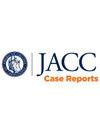Iatrogenic Reopening of a Congenital VSD After TAVR
Q4 Medicine
引用次数: 0
Abstract
Background
Transcatheter aortic valve replacement (TAVR) has become an increasingly used technique for patients with severe aortic stenosis who are at high risk of perioperative mortality during surgical valve replacement.
Case Summary
Here we describe the first case to our knowledge of a patient with a congenital perimembranous ventricular septal defect with prior spontaneous closure who experienced a post-TAVR acquired intracardiac shunt (AICS) due to the reopening of her ventricular septal defect, which caused new-onset heart failure and required surgical closure.
Discussion
AICS is a known complication of TAVR, but its risk in patients with congenital heart disease, particularly of the intraventricular septum, is poorly understood.
Take-Home Messages
In patients with congenital heart disease, detailed structural imaging should be obtained to better understand the anatomy before TAVR. Additionally, any patient with new-onset heart failure post-TAVR should be promptly evaluated for AICS.
先天性室间隔缺损TAVR术后医源性再开
背景:经导管主动脉瓣置换术(TAVR)已越来越多地应用于重度主动脉瓣狭窄患者,这些患者在瓣膜置换术中围手术期死亡率很高。病例总结:在这里,我们描述了据我们所知的第一例先天性膜周围室间隔缺损患者,先前自发性关闭,由于室间隔缺损的重新开放,她经历了tavr后获得性心内分流术(AICS),导致新发心力衰竭,需要手术关闭。aics是TAVR的一种已知并发症,但其在先天性心脏病患者,特别是室间隔患者中的风险尚不清楚。对于先天性心脏病患者,在TAVR前应获得详细的结构成像以更好地了解解剖结构。此外,任何tavr后新发心力衰竭的患者都应及时评估AICS。
本文章由计算机程序翻译,如有差异,请以英文原文为准。
求助全文
约1分钟内获得全文
求助全文
来源期刊

JACC. Case reports
Medicine-Cardiology and Cardiovascular Medicine
CiteScore
1.30
自引率
0.00%
发文量
404
审稿时长
17 weeks
 求助内容:
求助内容: 应助结果提醒方式:
应助结果提醒方式:


